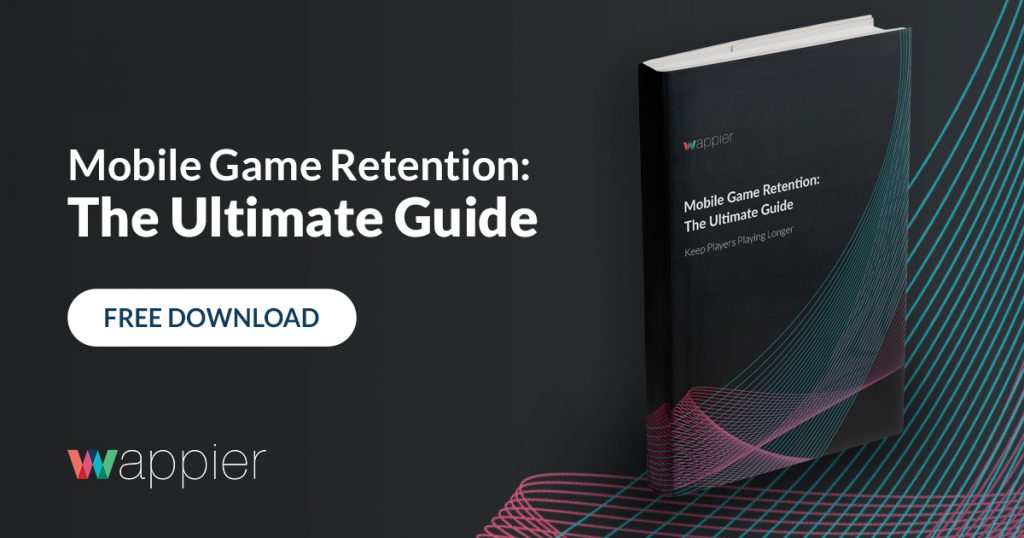Improving retention is one of the most critical jobs of any app marketer. Getting users to download an app is one thing, but getting them to keep coming back is another challenge entirely. In 2019, only 32% of users returned to an app 11 times or more. Across all categories, retention rates drop dramatically around the 7-day and one-month marks.
To help app marketers get a better idea of what retention rates look like throughout the mobile industry, we’ve rounded up the most actionable mobile app retention rate statistics from a variety of different sources. From general stats, to gaming and non-gaming apps, to iOS vs. Android, here’s everything you need to know about typical app retention.
Jump to a section…
General App Retention Rate Statistics
Gaming App Retention Rate Statistics
Non-Gaming App Retention Rate Statistics
Mobile OS Retention Rate Statistics
What Are Mobile App Retention Rates?
Simply put, app retention refers to the number of users who continue using the application after downloading it. Typically, marketers and mobile technology providers measure retention at several different times — such as Day 1, Day 7, Day 30, and so forth — to get an idea of how many users are sticking around for the long-term. This helps inform retention strategy and reduce churn.
There are many different factors that might determine an app’s retention, including mobile operating system, app type, game genre, and geographical location. All of these factors need to be taken into consideration in order to form an effective retention strategy.
General App Retention Rate Statistics
Organic Users Are Slightly Better Retained Long Term
In a study of over 15,000 apps with at least 1,000 non-organic installs per country per month, AppsFlyer analyzed retention from organic and paid installs. The data showed that while organic and non-organic retention is pretty much neck-and-neck for the first month, organic users ultimately stick around longer in the long term.
Organic retention rates:
- Day 1: 26.1%
- Day 7: 10.3%
- Day 30: 4.5%
- Week 8: 7.9%
Non-organic retention rates:
- Day 1: 26.9%
- Day 7: 9.7%
- Day 30: 3.6%
- Week 8: 6.0%
Source: AppsFlyer
From September 2018 to August 2019, Liftoff collected data from 992 apps, including 349 billion ad impressions, 5.35 billion clicks, and 128 million installs. Like AppsFlyer, Liftoff found that organic installs lead to greater retention over time.
Global mobile app user retention:
- Day 1: 25.2%
- Day 3: 13.1%
- Day 7: 8.6%
- Day 14: 5.8%
- Day 30: 3.5%
Mobile app retention by source:
- Day 1: Organic 25.2%; Non-organic 26.7%
- Day 3: Organic 13.3%; Non-organic 13.9%
- Day 7: Organic 9.1%; Non-organic 8.8%
- Day 14: Organic 6.3%; Non-organic 5.6%
- Day 30: Organic 3.8%; Non-organic 3.2%
Source: Liftoff
Average App User Churn Over 3 Months is 72.76%
As Upland Localytics put it in a 2019 report, “retention and churn are some of the best ways to diagnose problems and successes in your mobile platforms.” When looking at retention and churn rates from its database of 37,000 apps, these stats will help you determine whether your app is retaining users well or churning at above-average rates.
Three-month retention and churn rates:
- Month 1: 42.29% retention, 57.71% churn
- Month 2: 32.13% retention, 67.87% churn
- Month 3: 27.24% retention, 72.76% churn
Source: Upland Localytics
If you’re struggling to explain why users are churning, consider how in-app advertisements could be affecting the experience. Tapjoy has found that users respond more positively to value-exchange models like offerwalls, a literal wall of offers that users complete for in-app rewards.
- 62% of users who open the offerwall once will do so again
- 43% of users who complete one offer will complete more in the future
- 45% of users would stop using an app if the offerwall was removed
Source: Tapjoy
Targeted Push Notifications Benefit App Retention
Targeted push notifications are 293% more impactful in retaining users than broadcast push notifications, according to an Urban Airship study of more than 1,000 apps and 3.8 billion push notifications. In other words, highly personalized messages are more successful than general announcements when it comes to retaining users.
Source: Urban Airship
Gaming App Retention Rate Statistics
Social Casino Players Are Among The Most Loyal
Mobile gaming is a multi-billion-dollar industry, so it’s no surprise that app publishers are trying to capitalize on that popularity. Liftoff studied retention rates from a handful of common mobile game genres to find which ones worked best for retaining users.
Casual gaming app retention rates:
- Day 1: 31.1%
- Day 7: 9.8%
- Day 30: 3.5%
Hardcore gaming app retention rates:
- Day 1: 29%
- Day 7: 9%
- Day 30: 3%
Midcore gaming app retention rates:
- Day 1: 29.3%
- Day 7: 7.3%
- Day 30: 2%
Social casino gaming app retention rates:
- Day 1: 31.2%
- Day 7: 12.2%
- Day 30: 5.3%
Source: Liftoff
Poor Game Performance & Mismatched Skill Cause Churn
So why are players leaving your mobile game? Newzoo conducted community research to find the most common reasons. Newzoo’s study looked at both loyal players (those who had played for a year or more) and newer players with under three months of playtime.
Reasons for churn based on in-game frustrations:
- In-game lag: 54% loyal players, 39% new players
- Other players are too good: 39% loyal players, 24% new players
- Pay-to-win mechanics: 24% loyal players, 27% new players
- Other players aren’t nice: 15% loyal players, 6% new players
- Too many bugs: 12% loyal players, 4% new players
- Not enough new content: 9% loyal/new players
- No frustrations: 5% loyal players, 9% new players
Source: Newzoo
Targeted Push Notifications Benefit Game Retention
Much like the general stats seen above, Urban Airship found that highly targeted push notifications in games are far more effective than broadcast push notifications.
- Broadcast push notification open rate: 25.88%
- Highly targeted push notification open rate: 91.87%
Source: Urban Airship
Game Publishers Should Target 35% Day 1 Retention
GameAnalytics gathered insights from up to 100,000 mobile games and 1.2 billion global monthly players to determine the ideal retention targets for mobile game publishers. This study also broke down retention rates by specific genre, because not all types of games perform equally well on the mobile platform.
Suggested gaming app retention targets:
- Day 1: 35%
- Day 7: 11%
Median benchmarks by genre, day 1:
- Action: 20% to 25%
- Adventure: 20% to 25%
- Arcade: 25% to 30%
- Casual: 25% to 30%
- Puzzle: 25% to 30%
- Board: 25% to 30%
- Card: 30% to 25%
- Casino: 30% to 35%
- Trivia: 30% to 35%
- Word: 30% to 35%
- Multiplayer: 20% to 25%
- RPG: 25% to 30%
- Simulation: 20% to 25%
- Strategy: 30% to 35%
- Racing: 20% to 25%
- Sports: 25% to 30%
Median benchmarks by genre, day 7:
- Action: 2% to 5%
- Adventure: 2% to 5%
- Arcade: 8% to 10%
- Casual: 5% to 8%
- Puzzle: 8% to 10%
- Board: 8% to 10%
- Card: 10% to 12%
- Casino: 12% to 15%
- Trivia: 10% to 12%
- Word: 12% to 15%
- Multiplayer: 2% to 5%
- RPG: 5% to 8%
- Simulation: 2% to 5%
- Strategy: 8% to 10%
- Racing: 2% to 5%
- Sports: 5% to 8%
Median benchmarks by genre, day 28:
- Action: 0% to 2%
- Adventure: 0% to 2%
- Arcade: 2% to 4%
- Casual: 0% to 2%
- Puzzle: 4% to 6%
- Board: 4% to 6%
- Card: 4% to 6%
- Casino: 4% to 6%
- Trivia: 2% to 4%
- Word: 6% to 8%
- Multiplayer: 0% to 2%
- RPG: 0% to 2%
- Simulation: 0% to 2%
- Strategy: 2% to 4%
- Racing: 0% to 2%
- Sports: 0% to 2%
Source: GameAnalytics
Non-Gaming App Retention Rate Statistics
Finance Users Are Among The Best Retained
Of course, the billions of smartphone users worldwide do more with their devices than play games. Upland Localytics’ study also looked at retention for apps in other categories like retail and media, while Urban Airship looked at notification effectiveness in several of its own categories.
Retail three-month retention:
- Month 1: 51.05%
- Month 2: 40.39%
- Month 3: 35.31%
Finance three-month retention:
- Month 1: 51.64%
- Month 2: 42.5%
- Month 3: 35.79%
Media three-month retention:
- Month 1: 39.18%
- Month 2: 29.35%
- Month 3: 24.84%
Travel three-month retention:
- Month 1: 38.1%
- Month 2: 27.05%
- Month 3: 22.45%
Source: Upland Localytics
Ratio of broadcast push notifications to targeted notifications opened:
- Sports: 1.14 to 1
- Gambling: 1 to 95.15
- Entertainment: 5.44 to 1
- Media: 59.67 to 1
Source: Urban Airship
Mobile OS Retention Rate Statistics
iOS Users Are Better Retained Than Android Users
One of the toughest choices mobile marketers have to make is figuring out how to divide the budget between the two major mobile operating systems. Even though Android has a great market share, given that it’s on a higher number of phones from a variety of manufacturers, that doesn’t mean it should get a disproportionate chunk of the budget. iOS actually leads in retention, particularly at the Week 8 mark.
iOS retention rates:
- Day 1: 28.2%
- Day 7: 11.2%
- Day 30: 4.5%
- Week 8: 8.5%
Android retention rates:
- Day 1: 27.9%
- Day 7: 10.5%
- Day 30: 4.4%
- Week 8: 6.4%
Source: AppsFlyer
Android Users Are More Likely To Opt-In To Receive Notifications
On top of analyzing push notification and in-app messaging opt-in rates by OS, Upland Localytics also broke down open rate, conversion rate, and engagement by platform. Open rate refers to the percentage of users who open a message within a day of receiving it, while conversion means those who clicked on the message and performed the desired action within the same time period. Engagement was measured as the average number of sessions recipients had within a week of receiving a message.
iOS opt-in rate: 34.76%
Android opt-in rate: 81.21%
iOS open rate:
- Push: 3.49%
- In-app: 15.88%
Android open rate:
- Push: 3.6%
- In-app: 12.25%
iOS conversion rate:
- Push: 0.81%
- In-app: 5.98%
Android conversion rate:
- Push: 1.12%
- In-app: 4.13%
iOS engagement:
- Push: 3.44
- In-app: 21.45
Android engagement:
- Push: 2.94
- In-app: 18
Source: Upland Localytics
Geographic App Retention Rate Statistics
North American Users Are Slightly Better Retained
Where in the world are your users? Geographic location can result in slight variations in retention rates throughout the first month after an app is downloaded. As Liftoff detailed, North American mobile users are consistently more loyal than their global counterparts.
Asia-Pacific retention rates:
- Day 1: 25.2%
- Day 3: 12.6%
- Day 7: 8.1%
- Day 14: 5.3%
- Day 30: 3.1%
Europe, Middle East, & Africa retention rates:
- Day 1: 25.3%
- Day 3: 13%
- Day 7: 8.5%
- Day 14: 5.7%
- Day 30: 3.5%
Latin America retention rates:
- Day 1: 25.9%
- Day 3: 12.7%
- Day 7: 7.9%
- Day 14: 5%
- Day 30: 2.8%
North America retention rates:
- Day 1: 26.5%
- Day 3: 13.8%
- Day 7: 8.9%
- Day 14: 5.9%
- Day 30: 3.5%
Source: Liftoff
As these stats show, there’s no shortage of factors that might determine an app’s retention rate. App quality, operating system, geographic location, ads, notifications — these are all pieces of the larger ecosystem. When studying your own retention rates, consider addressing these variables to lower churn and keep users around longer.
Sources
- Attention: Retention! 2019 App Retention Benchmarks – AppsFlyer
- 2019 Mobile App Benchmark Report – Upland Localytics
- Mobile App Trends Report 2019: A Growing Mobile Economy – Liftoff
- Newzoo
- The Good Push Index: How Targeting Boosts Push Notification Response Rates – Urban Airship
- The Ultimate Offerwall Guide – Tapjoy
- Mobile Gaming Benchmarks (June 2018 – June 2019) – GameAnalytics






